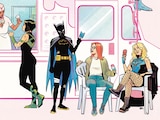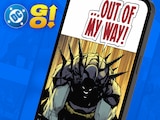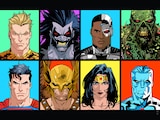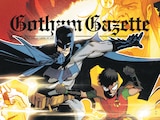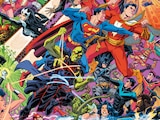If a story is called “Crisis on Infinite Earths,” then it probably means Supergirl is about to have a bad time. Kara Zor-El was killed in the original 1985 comic book series, and the 2019 television crossover began with the destruction of Argo City, resulting in the death of Supergirl’s parents. Characters like Batman and Green Lantern usually come out of Crisis relatively unscathed, while Supergirl needs therapy (or a casket).
Justice League: Crisis on Infinite Earths – Part Two is no exception. Worlds die, heroes fall and Supergirl goes through the emotional wringer. It’s a rough movie for Kara, but in many ways, it’s made me appreciate her more. Don’t get me wrong, I’ve always loved Supergirl, but Crisis on Infinite Earths – Part Two has me taking a second look at the character and her origin.

Let’s start with the differences between Superman and Supergirl. Kal-El was launched from Krypton as an infant (or a toddler, depending on the continuity). There are some Silver Age stories where he retains memories of his homeworld, but for the most part, Superman didn’t learn about Krypton until adulthood. The loss of his parents, his culture and his entire planet doesn’t weigh heavily on him because they perished before he could form any long-term memories.
Kara is a different story. In some versions of continuity, Kara grew up on Krypton, while others have her being raised on a floating asteroid called Argo City. Either way, Kara Zor-El was a teenager when her world perished. She had to cope with the death of everyone she had ever known. It’s easy to forget this as you read Kara’s first appearance in 1959’s Action Comics #252.
As Kara recounts her origin to Superman, she briefly gets choked up. However, this lasts for two panels, and she spends the rest of the issue smiling and acting upbeat. In fact, when Kara’s rocket lands on Earth, she emerges from the vessel acting absolutely chipper.

It’s important to remember that this was 1959, and DC had to work within certain storytelling parameters. Kara’s story had to be told within a certain page count, and editorial was writing for a younger readership. The comic book medium would evolve over time, allowing DC to explore themes like grief and survivor’s guilt. Future retellings of Kara’s origin expanded on those ideas, but audiences weren’t ready in 1959.
Crisis on Infinite Earths – Part Two explores Supergirl’s origin in a way that made me fall in love with the character all over again. During the film, we learn that after Krypton’s destruction, Kara spent some time on the Monitor’s ship before landing on Earth. The Monitor was initially reluctant to save the young refugee, but his robot aide Satellite pushed him into it.
When they find Kara, she is suffering from radiation poisoning. The young girl has trouble remembering who she is and where she came from. Satellite believes this is due to a head injury, but my theory is psychological trauma. The film never states as much, but perhaps her mind shut down after she witnessed the destruction of her world.

Kara’s memories begin to return when she finds her ship. She orders it to return her to Krypton, but the ship informs her that Krypton no longer exists. A video recording plays, showing the destruction of Krypton. Pay attention to Kara’s eyes in this scene because there is a lot going on.
In short, Kara’s experiencing a tsunami of grief as the memories of her trauma are returning. At the same time, she’s being forced to relive the moment as she watches a video of Krypton’s apocalypse. She’s experiencing the worst moment of her life—twice. In addition, she’s coming to the realization that the Monitor has been lying to her. He knew her world was destroyed, but he kept that information from her. All of this information is washing over her in a matter of seconds.
This isn’t communicated with dialogue, but we see it in the way her eyes are animated. The next time someone argues that animation isn’t art, remember this scene.
For most people, this would be a moment that broke them. How could you come back from this? Everyone you ever loved is dead, and your surrogate family has been lying to and manipulating you. However, this moment drives Kara to become a hero. “I’m through waiting, and watching, and doing nothing. I’m the opposite of you, and I’m going to do something,” Kara angrily tells the Monitor.

When you look at the big picture, you realize how lucky Clark was to be found by Jonathan and Martha Kent. Clark got to grow up with loving parents, while Kara was imprisoned and manipulated. Despite all that, she still chose to become a hero.
When we catch up with Kara in the present-day scenes, the Crisis is weighing heavily on her. Seeing multiple worlds die brings back the trauma of her planet’s destruction.
“You don’t even remember Krypton! I lost my whole world, and now I get a new home! Gone! No Earth, they never existed, they never will exist,” she tells Superman. It’s a powerful line and voice actress Meg Donnelly delivers it passionately. We hear the grief in Kara’s voice as we realize just how much she has been carrying.
Part Two delivers a powerful emotional arc for Supergirl, but it’s important to remember that it’s not over yet. Justice League: Crisis on Infinite Earths – Part Three is on the horizon and there’s no telling what’s in store for Kara. As I mentioned earlier the Crisis on Infinite Earths comic is famous for killing off Supergirl, so Kara fans have plenty of reasons to be concerned. Whether she lives or dies, this animated adaptation has given me a new appreciation for Girl of Steel. I’ll never look at the character the same way again.
Justice League: Crisis on Infinite Earths – Part Two is now available on 4K UHD, Blu-ray and Digital.
Joshua Lapin-Bertone writes about TV, movies and comics for DC.com, is a regular contributor to the Couch Club and writes our monthly Batman column, "Gotham Gazette." Follow him on Twitter at @TBUJosh.
NOTE: The views and opinions expressed in this feature are solely those of Joshua Lapin-Bertone and do not necessarily reflect those of DC or Warner Bros. Discovery, nor should they be read as confirmation or denial of future DC plans.






